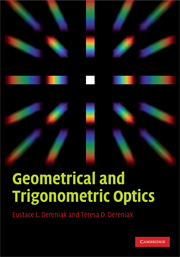Book contents
- Frontmatter
- Contents
- Preface
- 1 Light propagation
- 2 Reflections and refractions at optical surfaces
- 3 Image formation
- 4 Mirrors and prisms
- 5 Curved optical surfaces
- 6 Thin lenses
- 7 Thick lenses
- 8 Mirrors
- 9 Optical apertures
- 10 Paraxial ray tracing
- 11 Aberrations in optical systems
- 12 Real ray tracing
- Appendix A Linear prism dispersion design
- Appendix B Linear mixing model
- Appendix C Nature's optical phenomena
- Appendix D Nomenclature for equations
- Appendix E Fundamental physical constants and trigonometric identities
- Glossary
- Index
- References
8 - Mirrors
Published online by Cambridge University Press: 06 July 2010
- Frontmatter
- Contents
- Preface
- 1 Light propagation
- 2 Reflections and refractions at optical surfaces
- 3 Image formation
- 4 Mirrors and prisms
- 5 Curved optical surfaces
- 6 Thin lenses
- 7 Thick lenses
- 8 Mirrors
- 9 Optical apertures
- 10 Paraxial ray tracing
- 11 Aberrations in optical systems
- 12 Real ray tracing
- Appendix A Linear prism dispersion design
- Appendix B Linear mixing model
- Appendix C Nature's optical phenomena
- Appendix D Nomenclature for equations
- Appendix E Fundamental physical constants and trigonometric identities
- Glossary
- Index
- References
Summary
In Chapter 2 we introduced the concept of a plane mirror and its effect on the handedness of an image. An effect of Snell's law provides the law of reflection: the angle of incidence is equal to the angle of reflection, along with a sign change relative to the normal of the surface (see Equation (2.14)). Rays from an object or any point on the object are reflected according to Snell's law in the plane of incidence. The plane of incidence is the plane composed of the incident ray and the surface normal, as shown in Figure 8.1, in which the plane of the paper contains the ray and the normal (η).
As discussed in Chapter 2, the image of point P is located as far behind the mirror as the point is in front of the mirror. For an extended object made up of a continuum of points, as shown in Figure 8.2, the image is located by tracing rays backward in the plane of incidence. The image of the arrow has been inverted upon reflection, and point A′ is below point B′ on this image. What we have been doing is ray tracing in the plane of incidence. If we look at the object directly, we see a different orientation in the plane of incidence than we do if we look at the object via the mirror. An observer looking at the object and image, as shown in Figure 8.3, sees an inverted image.
- Type
- Chapter
- Information
- Geometrical and Trigonometric Optics , pp. 193 - 225Publisher: Cambridge University PressPrint publication year: 2008



